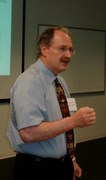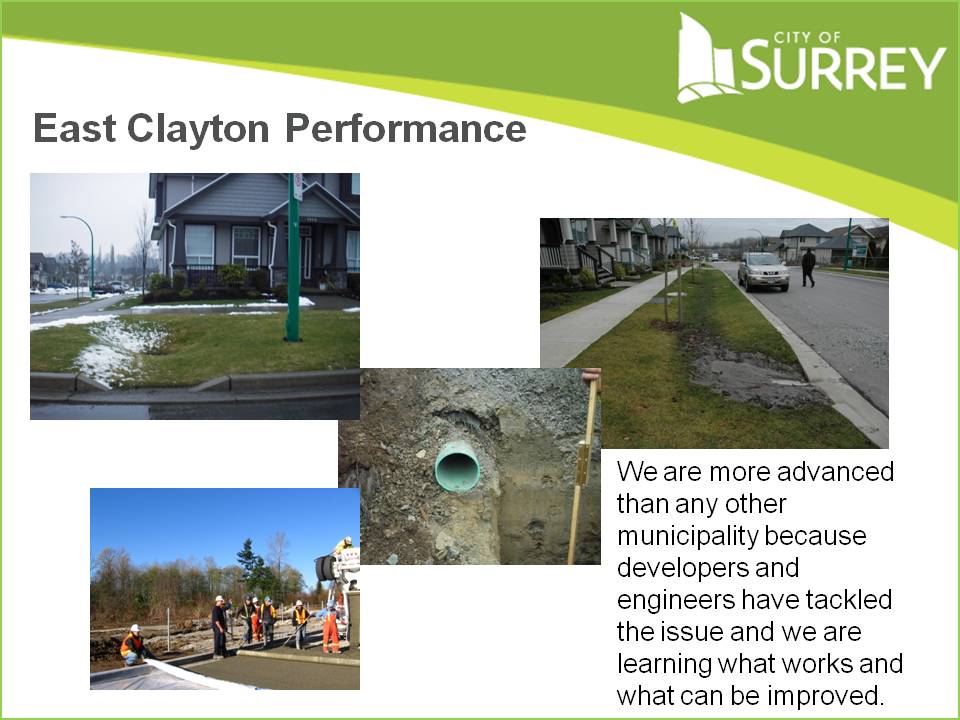OKANAGAN RAIN TO RESOURCE WORKSHOP: East Clayton ‘Green’ Development in Surrey established BC precedent for implementation of ‘Low Impact Development’ techniques and facilities
Note to Readers:
Day 1 of the From Rain to Resource Workshop on October 28, 2010 in Kelowna was geared toward technical operational and planning staff . The focus was on site-level best practices and tools to deal with various situations. One of the case studies was the East Clayton ‘green’ development in the City of Surrey.
Green Infrastructure Innovation
 “The East Clayton development in Surrey was the first development in the Lower Mainland that utilized Low Impact Development (LID) techniques and facilities. The need to embrace LID practices arose from the need to prevent further increases in damage to both the environment and the agricultural community resulting from the increases in runoff from urban areas,” explains Jim Dumont, the Engineering Applications Authority for the Inter-Governmental Partnership that is responsible for the Water Balance Model. He will the East Clayton story at the Okanagan workshop.
“The East Clayton development in Surrey was the first development in the Lower Mainland that utilized Low Impact Development (LID) techniques and facilities. The need to embrace LID practices arose from the need to prevent further increases in damage to both the environment and the agricultural community resulting from the increases in runoff from urban areas,” explains Jim Dumont, the Engineering Applications Authority for the Inter-Governmental Partnership that is responsible for the Water Balance Model. He will the East Clayton story at the Okanagan workshop.
Rainfall Capture Objectives
“The Neighbourhood Concept Plan (NCP) established rainfall capture objectives to maintaining the predevelopment runoff rates and volumes. The first phase of development brought the need to create calculation methods to verify that the designs complied with the NCP requirements.”
“The clay soils and limited infiltration rates drove innovation in both the calculation methods and the design details to allow the volumetric runoff coefficient to be maintained in both single family and multi-family sites. This was the first step in creating the methods used in the Water Balance Model as it exists today.”
To Learn More:
Click on City of Surrey – “From Pilot Projects to a Watershed Objectives Approach” –—Paul Ham looks back at the provincial initiatives that influenced the East Clayton sustainable community: the East Clayton Neighbourhood Concept Plan provided the first large-scale opportunity to ‘test’ a new approach which is sometimes characterized as ‘the future is the past’.
Click on East Clayton Sustainable Community: Lessons Learned On-the-Ground in Surrey, British Columbia — The three objectives or learning outcomes in featuring East Clayton at the 2009 Surrey Water Balance Model Forum were: provide the sustainability context; review the implementation experience for private and public rainfall capture systems; and reflect on lessons learned.
Click on Showcasing Innovation in the City of Surrey: Second in 2006 series under umbrella of the Celebrating Green Infrastructure Program — The focus was on what the City believes it can systematically accomplish on-the-ground, at a watershed scale, now and over the next 50 years by building on the East Clayton experience.
Genesis for Stream Health Methodology
Looking back, application of the water balance methodology to East Clayton can now be seen as the genesis for the Stream Health Methodology that is embedded in the Water Balance Model powered by QUALHYMO.
Application of Performance Targets
“With hindsight, the significance of East Clayton is two-fold. It was an early application of performance targets at a neighbourhood scale. Also, and most importantly the analysis combined mass balance and flow duration to test the achievability of performance targets,” states Jim Dumont.
“But it was the South Newton case study where the methodology really came together in terms of how to integrate the mass balance and stream erosion analyses. Until then, they were separate analyses.”
“In South Newton, we were able to demonstrate that distributed rainwater infiltration systems could result in a multi-million dollar net reduction in the City’s 10-Year Capital Plan, while enabling development to proceed. The saving results from elimination of a number of detention ponds.”
“The experience gained in East Clayton and South Newton was then applied in Fergus Creek. The Beyond the Guidebook methodology was formalized as the Stream Health Methodology, and subsequently incorporated in the Water Balance Model when it was integrated with the QUALHYMO engine. The Stream Health Methodology is a function of flow duration, and hence stream erosion,” concludes Jim Dumont.
To Learn More:
Click on Application of the “DFO Urban Stormwater Guidelines” has evolved over the past decade to protect stream health — This story provides context for the 4-page ‘Urban Stormwater Guidelines and Best Management Practices for Protection of Fish and Fish Habitat’ – how they set a direction in 2001; how they have evolved into ‘Beyond the Guidebook’; and how the Water Balance Model is a tool to correlate runoff volume management with stream erosion and water quality outcomes.
Click on Beyond the Guidebook 2010 Advances Runoff-Based Approach to Setting Watershed Performance Targets — “A framework for developing integrated and holistic plans is consolidated in a single table. This ‘mind-map’ lays out the cascading logic for establishing, evaluating and implementing watershed-specific runoff targets that will protect stream health.”
Click on A crucially important message in Beyond the Guidebook 2010: “We now have the tools and experience to design with nature” — “So many in local government are searching for the magical ‘silver bullet’to resolve watershed issues and challenges. Yet soil, vegetation and trees can do more for our watersheds than decades of planning, consulting and complicated engineering design will ever achieve.”
Click on Water Balance Model can create an understanding of the past and compare it to many possible futures — “A key message is that the Water Balance Model is a ‘scenario comparison tool’. This is where the WBM shines as it is not constrained by starting or ending points. It compares whatever the user can envision.”
Posted October 2010




